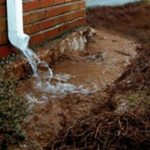Houses built for veterans returning from World War II went up in large numbers between the late 1940s and the end of the 1950s. What should you expect if you buy one? Houses age. Some age gracefully. Some get updated and renovated. Some updates and renovations fail.
I looked at an inspection report of a 1948 house. I felt a sense of deja vu. This report was for a house I’ve never seen. It came from a cousin’s son (also a cousin!) who was purchasing in the Maryland area with Victoria and Ron Henderson. Buyer’s Edge, in Bethesda is one of my favorite exclusive buyer’s brokers. The pictures of the problem areas look like the problem areas I see on so many houses of this age.
These houses are 60-70 years old. How are they holding up?
 Generally speaking, they hold up pretty well. These are the kinds of problems that we tend to see that are specific to this kind of house:
Generally speaking, they hold up pretty well. These are the kinds of problems that we tend to see that are specific to this kind of house:
- When these houses were built, there was not enough thought given to how water drains away from them. Many were built on lots that were not graded in a way to encourage water to flow away from the foundation. With a postwar house, look for modifications to gutter and downspout systems; most owners have done something, but only some are successful.
- Because water collects around the foundation, many of these houses have dampness in their basements. Look for sump pumps and French drain systems; most owners have done something, but only some are successful.
- Porches, garages, and sometimes main house shingles and wood trims were installed all the way down to ground level. This leads to wood rot and can attract wood boring insects, such as carpenter ants and termites.
- These houses were built with old insulation standards. If the previous owners did not add insulation and roof ventilation, it should be on your “to do” list.
- Two house components are expected to last for fifty to sixty years or so before they need attention. You may be the lucky owner who get to do this work.

- The main electric line is a cloth-covered line without a conduit. The cloth is wearing thin by now.
- Bricks last a long time, but the mortar on your chimney is pretty eroded by now.
Normal maintenance cycles: Houses need new roof components every twenty years or so. Boilers last about thirty years, forced hot air systems about fifteen to twenty before being replaced. So, depending on the previous owners, some of these components may be at the end of its economic life. That is true of every house over fifteen years old.
More about the history of post-war houses. (link)
I grew up in a 1956 Cape Cod postwar house. These houses went up in large numbers, in an organized, mass-production sort of way. When the kids in my neighborhood got bored one summer, we charted the houses on our block. This is what we found:
- There were four pre-existing house lots in the square block.
- When we skipped over the pre-existing houses, we discovered that all the houses had the exact same foundation.
- The variations involved where the entry foyers was placed (front of side), where the front door was placed (centered, left, or right), direction of the stairway (parallel or perpendicular to the front wall.)
- There was a total of seven designs that repeated twice in the fourteen houses around our block.
The post-war houses have all been altered some. The landmark “original” on Long Island is not restored entirely to its original state. Mostly, the smaller versions of these houses have had additions, or have been torn down, or both. The larger ones are still standing, still being bought and happily lived in.


Leave A Comment